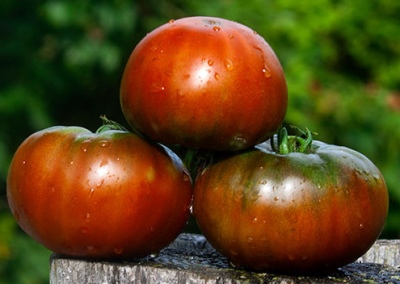
- Name synonyms: Cindao
- Category: grade
- Growth type: indeterminate
- Appointment: fresh consumption, for juice, for ketchup and tomato paste
- Ripening period: mid-season
- Ripening time, days: 105-115
- Growing conditions: for greenhouses
- Transportability: No
- Bush size: tall
- Bush height, cm: up to 150
The Qingdao tomato is a classic member of the nightshade family, which forms large fruits with rich tomato notes. Thanks to these taste indicators, the variety is popular both with lovers of fresh salads and those who prefer to make preparations. Universal fruits can be used for making sauces, juices, salads and other types of preservation. Despite the simplicity of care, a productive variety in mid-climatic latitudes is best grown in greenhouse conditions; in regions with warmer air masses, the plant can be grown directly in open beds.
Description of the variety
The Qingdao tomato (Cindao) belongs to the group of indeterminate nightshade, with a central trunk height of 130 cm to 150 cm. The plant belongs to mid-season varieties, in which the stage of technical ripeness occurs 115 days from the moment the first shoots appear. The plant is able to form about 8 ovaries on one brush. This property is possible due to the presence of a strong green frame with a large deciduous mass.
An adult plant requires compulsory pinching and fixation to a support. The maximum yield can be achieved only if no more than 3 branches are left on the bush.
Advantages:
high taste indicators;
the formation of large fruits;
high yield rates;
the ability to grow in various climatic conditions;
resistance to deformation of the skin;
unpretentiousness;
mass formation of fruits.
Disadvantages:
low keeping rates;
damage to fruits during late harvest;
impossibility of transportation.
The main qualities of the fruit
Large fruits of this variety have a flattened rounded shape. Under favorable conditions, the mass of one fruit can reach from 400 grams to 500 grams. Average weight indicators are rarely below 250 grams. Tomatoes have a dense, juicy and fleshy structure of dark cherry color with a high content of sugars. The color range of fruits ranges from deep brown to burgundy. A distinctive feature is the presence of a green spot at the point of attachment of the petiole, as well as the formation of a large number of seed compartments, which are located in the upper layers. Fleshy and juicy fruits have a very short shelf life and are unsuitable for long-term transportation, which significantly reduces the economic profit from their sale.
Taste characteristics
At the stage of technical ripeness, the fruits acquire a rich tomato shade, which allows them to be used both for preparing fresh salads and for creating tomato blanks.
Ripening and fruiting
The technical ripeness of the fruits of this variety occurs on the 105-115th day from the moment the first shoots appear. Fruit ripening is amicable.
Yield
Qingdao tomato belongs to high-yielding varieties, in which about 8 fruits can be formed on one bunch, and the yield of one bush often reaches 9 kg. Up to 30 kg of sugar can be harvested from a 1 m2 plot. You can increase yields by removing the growth point.
The timing of planting seedlings and planting in the ground
To obtain a high-quality seedling mass, the seed material must be planted two months before the start of the planting campaign. Due to the absence of hybridization, the collection of seed material can be carried out independently, which in no way will affect the yield and quality of the fruit. To improve the germination of seeds, they must be treated with disinfecting compounds and growth accelerators.
It is necessary to dive seedlings at the stage of formation of 2-3 leaf plates. The optimal temperature regime for growing seedlings is in the range from +20 degrees to +25 degrees with a humidity of at least 65%.
Fortified and hardened seedlings, practical breeders recommend planting from mid-May. Before planting in open ground, the soil must be treated with wood ash, which will help to significantly neutralize its acidity.

Growing tomato seedlings is an extremely important process, because it largely depends on whether the gardener can harvest at all. All aspects must be taken into account, from seedbed preparation to planting in the ground.
Landing scheme
The planting pattern for the dark-skinned variety is the same as for all tall tomatoes. On a plot of 1 m2, there should not be more than 3-4 plants.

Growing and care
A high-yielding large-fruited variety does not require increased attention to itself during cultivation, however, the plants must be watered abundantly as the soil dries. For the formation of juicy fruits, the soil near the bushes must be regularly enriched with mineral and organic fertilizers. Tall plants must be attached to a secure support. Do not forget about the regular removal of excess shoots, as well as the fight against weeds and pests.




A plant needs different micronutrients at each stage of growth. All fertilizers can be divided into two groups: mineral and organic. Folk remedies are often used: iodine, yeast, bird droppings, eggshells.
It is important to observe the rate and period of feeding. This also applies to folk remedies and organic fertilizers.
Disease and pest resistance
Despite the huge number of advantages, this variety has a low resistance to diseases of the nightshade family, which greatly complicates the process of caring for the plant.Most often, the plant suffers from fusarium, late blight and all types of gili. Untimely treatment of plants from diseases can lead not only to a decrease in yield, but also to the death of green spaces.



























































































